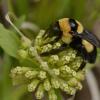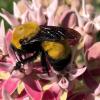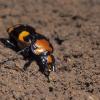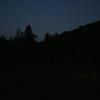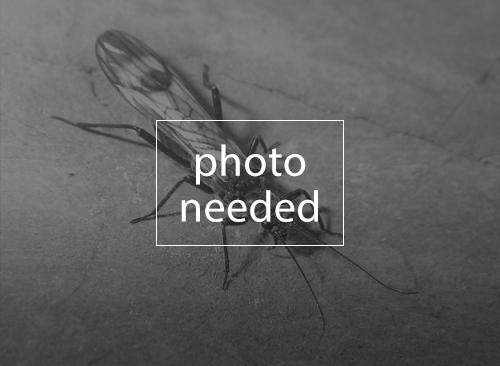
(Gastropoda: Hydrobiidae)
Pyrgulopsis fresti is a springsnail living in the Owyhee River basin and adjacent drainages. It can be distinguished from other snails in the genus by its broad, low-spired, squat shell and the large, disc-shaped, glandular ornament on its penis. This species has an entirely aquatic life cycle, feeding on algae gleaned from the substrate and aquatic vegetation. The Owyhee hot springsnail requires clean, moderately swift, well-oxygenated waters, typically with gravel-boulder substrates. It inhabits thermal springs with temperatures of 24 to 33°C (Hershler and Liu 2009). The only area with known habitat for this species is in a major river canyon with exposed basalt and other volcanic lithologies, in open and dry sage scrub (Frest and Johannes 1995). Since thermophilic Pyrgulopsis species are generally very rare and highly endemic, they are particularly sensitive to threats such as livestock grazing, recreational activities, diversion of water source, and introduction of non-native or invasive species (Hershler 1998, Sada and Vinyard 2002).
Pyrgulopsis is a genus of tiny, gilled, operculate, aquatic snails in the family Hydrobiidae. This species-rich genus is characterized as follows (Call and Pilsbry 1886): the shell is minute (<6 mm in length), conically turreted, somewhat elongated, imperforate, and unicarinate, with an acute apex. The aperture is ovate and the peritreme is continuous. The operculum is ovate, thin, corneous, and spiral, with the polar point well forward and approximating the columella (Call and Pilsbry 1886). The similarities in external shell morphology between taxa in this family makes identification to species based on shell characters problematic (Frest and Johannes [n.d.]). Because of this, the distinctions between species within the genus Pyrgulopsis have typically been made based on the number and arrangement of glands on the penis and other reproductive structures. DNA analysis is another tool that people have begun to use to separate species in this genus.
Taxonomic status
In addition to having unique mitochondrial DNA sequences, Pyrgulopsis fresti is readily distinguished from P. owyheensis and other congeners living in the Owyhee River basin and adjacent drainages by its broad, low-spired, squat shell and the large, disc-shaped, glandular ornament on its penis (Hershler and Liu 2009). It also differs from these species in that it lacks a seminal receptacle, a character which it uniquely shares with P. arizonae (Taylor 1987). Pyrgulopsis fresti is similar to P. bruneauensis but is differentiated by its smaller, more strongly globose shell, larger penial lobe, and shorter penial filament (Frest and Johannes 1995, Hershler and Liu 2009).
Members of the Pyrgulopsis genus have an entirely aquatic life cycle, feeding on algae gleaned from the substrate and aquatic vegetation. In general, Hydrobiid snails are sexually dimorphic, and the larger females tend to live longer. The lifespan of most freshwater snails is approximately two to five years (NatureServe 2009).
This recently described species is known only from a short reach (~6 km) of the middle Owyhee River, at the mouth of Warm Springs Canyon above the town of Three Forks, in Malheur County, Oregon (Hershler and Liu 2009). Most records are from Tudor Warm Springs, a large thermal spring complex where the species was discovered. It has also been found in springs and spring tributaries along the upflow from this complex (Hershler and Liu 2009). Note that the Tudor Warm Springs complex is unnamed on current United States Geological Survey topographic maps, but is referred to as Tudor Warm Springs by Hershler and Liu (2009), and others. Searches of warm springs by T. Frest, E. Johannes, R. Hershler, and associates throughout much of Interior Oregon and southern Idaho from approximately 1989 to 1994 did not result in additional sites (Frest and Johannes 1995).
Forest Service/BLM Lands: This species is documented on Vale District BLM land in Oregon.
The Owyhee hot springsnail requires clean, moderately swift, well-oxygenated waters, typically with gravel-boulder substrates. It inhabits thermal springs with temperatures of 24 to 33°C (Hershler and Liu 2009).
Global Status (2009): G1
Rounded Global Status: G1 – Critically Imperiled
National Status (United States): N1
State Status: Oregon: S1
(NatureServe 2009).
Modifications to springs that negatively impact Pyrgulopsis species include livestock grazing (which tramples vegetation and pollutes the spring with excrement), recreational activities (such as bathing), diversion of water source, and introduction of non-native or invasive species (Hershler 1998, Sada and Vinyard 2002). Since thermophilic Pyrgulopsis species are generally very rare and highly endemic, they are particularly sensitive to the above threats.
Although only recently named, Pyrgulopsis fresti was long considered to be a taxonomically valid and critically imperiled species, in clear danger of extinction due to very limited range, specialized habitat, and current and ongoing threats (Frest and Johannes 1995, Hershler and Liu 2009, Frest and Johannes [n.d.]). The area where this species occurs is grazed rather heavily and past modification of the springs for a bathing pool appears to have impacted the snail population, as they are absent from modified areas while still occurring immediately below and above (Frest and Johannes 1995). The current road access on the east side of the Owyhee River crosses some spring runs but is not heavily used (Frest and Johannes 1995).
Inventory: Additional surveys of seeps and springs along the Owyhee River in southeastern Oregon are needed to accurately delineate the geographic range of this species (Hershler and Liu 2009). Abundance estimates for this species at new and known sites would assist future conservation efforts, since population size is important in evaluating the stability of a species at a given locality.
Management: Protect all new and known sites and their associated watersheds from heavy grazing, water diversions, vehicle use, recreational use, and other practices that would adversely affect any aspect of this species’ life cycle. Riparian habitat protection, including maintenance of water quality, substrate conditions, and canopy cover, would likely benefit and help maintain this species.
Call, R.E. and H.A. Pilsbry. 1886. On Pyrgulopsis, a new genus of rissoid mollusk, with description of two new forms. Proceeding Davenport Academy of Natural Sciences, volume V: 9-14.
Frest, T.J. and E.J. Johannes. [n.d.]. Northwestern U.S. sensitive nonmarine molluks. Unpublished document. Available from E. Johannes.
Frest, T.J. and E.J. Johannes. 1995. Interior Columbia Basin mollusk species of special concern. Final report: Interior Columbia Basin Ecosystem Management Project, Walla Walla, WA. Contract #43-0E00-4-9112. 274 pp. plus appendices.
Hershler, R. 1998. A systematic review of the Hydrobiid snails (Gastropoda: Rissooidea) of the Great Basin, Western United States. Part I. Genus Pyrgulopsis. The Veliger 41(1):1-132.
Hershler, R. and Liu, H. 2009. New species and records of Pyrgulopsis (Gastropoda: Hydrobiidae) from the Snake River basin, southeastern Oregon: further delineation of a highly imperiled fauna. Zootaxa, 2006:1-22.
NatureServe. 2009. “Pyrgulopsis fresti.” NatureServe Explorer: An online encyclopedia of life [web application]. Feb. 2009. Version 7.1. NatureServe, Arlington, Virginia. 27 Sep. 2009. http://www.natureserve.org/explorer/
Sada, D.W. and G.L. Vinyard. 2002. Anthropogenic changes in biogeography of Great Basin aquatic biota. Pages 277-293 in R. Hershler, D.B. Madsen, and D.R. Currey (eds.). Great Basin Aquatic Systems History. Smithsonian Contributions to the Earth Sciences, Number 33. 405 pp.
Taylor, D.W. 1987. Freshwater molluscs from New Mexico and vicinity. New Mexico Bureau of Mines and Mineral Resources Bulletin 116:1-50.
Additional Resources
Profile prepared by Sarah Foltz Jordan, Sarina Jepsen and Julia Janicki, The Xerces Society for Invertebrate Conservation

